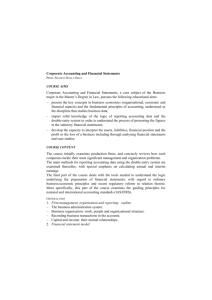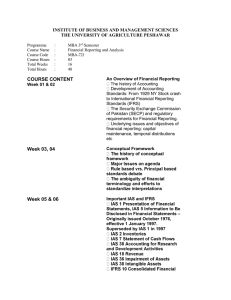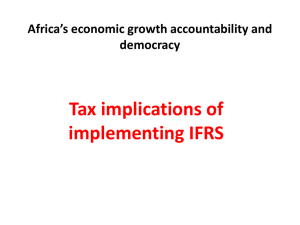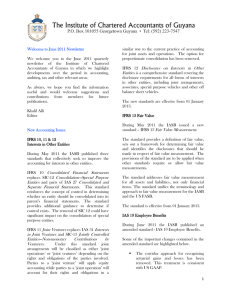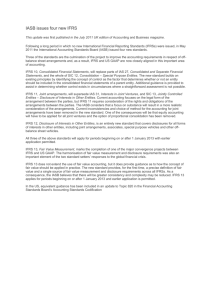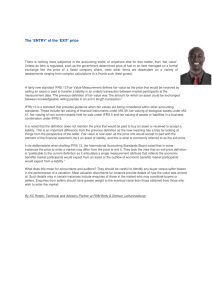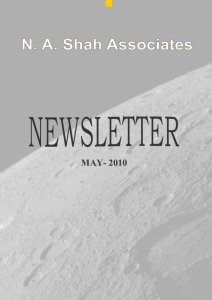CL15
advertisement
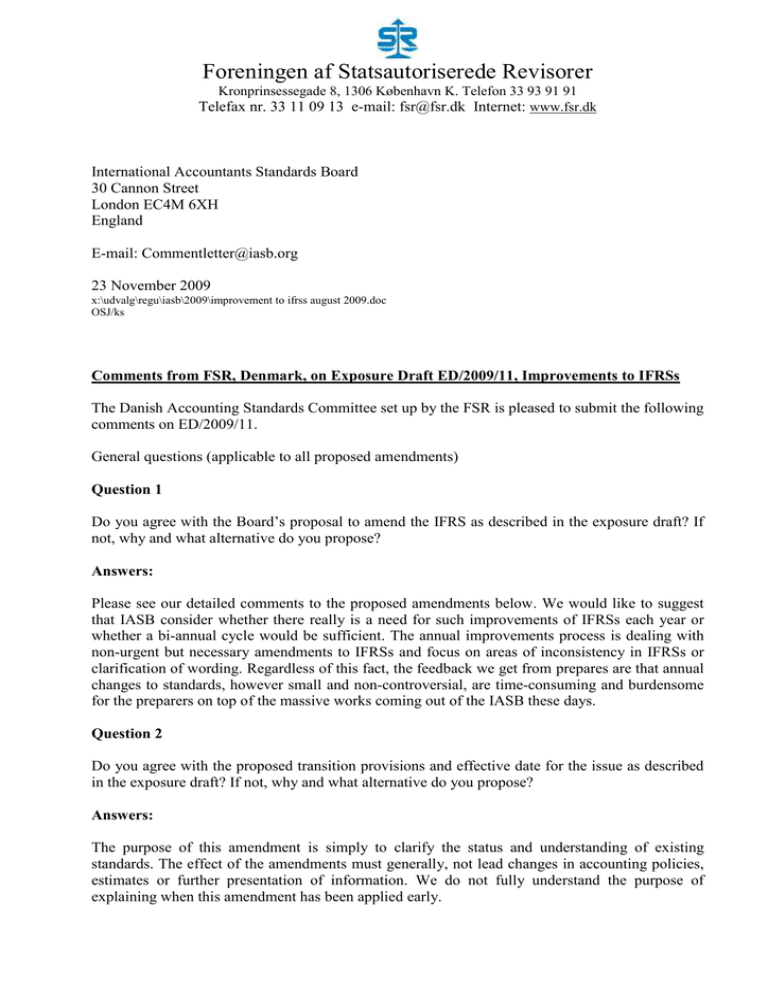
Foreningen af Statsautoriserede Revisorer Kronprinsessegade 8, 1306 København K. Telefon 33 93 91 91 Telefax nr. 33 11 09 13 e-mail: fsr@fsr.dk Internet: www.fsr.dk International Accountants Standards Board 30 Cannon Street London EC4M 6XH England E-mail: Commentletter@iasb.org 23 November 2009 x:\udvalg\regu\iasb\2009\improvement to ifrss august 2009.doc OSJ/ks Comments from FSR, Denmark, on Exposure Draft ED/2009/11, Improvements to IFRSs The Danish Accounting Standards Committee set up by the FSR is pleased to submit the following comments on ED/2009/11. General questions (applicable to all proposed amendments) Question 1 Do you agree with the Board’s proposal to amend the IFRS as described in the exposure draft? If not, why and what alternative do you propose? Answers: Please see our detailed comments to the proposed amendments below. We would like to suggest that IASB consider whether there really is a need for such improvements of IFRSs each year or whether a bi-annual cycle would be sufficient. The annual improvements process is dealing with non-urgent but necessary amendments to IFRSs and focus on areas of inconsistency in IFRSs or clarification of wording. Regardless of this fact, the feedback we get from prepares are that annual changes to standards, however small and non-controversial, are time-consuming and burdensome for the preparers on top of the massive works coming out of the IASB these days. Question 2 Do you agree with the proposed transition provisions and effective date for the issue as described in the exposure draft? If not, why and what alternative do you propose? Answers: The purpose of this amendment is simply to clarify the status and understanding of existing standards. The effect of the amendments must generally, not lead changes in accounting policies, estimates or further presentation of information. We do not fully understand the purpose of explaining when this amendment has been applied early. 2 With all these minor amendments and clarifications, the section on accounting policies regarding early adoption will, in practice, be very difficult to understand for users of the financial statements. This section should focus on early adoptions that lead to changes in accounting policies and significant changes in presentations, etc. We therefore generally recommend the Board to evaluate the need for very detailed transition provisions for this year’s improvement project. Specific questions Question 3 The Board proposes changes to IAS 34 Interim Financial Reporting to emphasize its disclosure principles. It also adds to the guidance to illustrate better how to apply these principles, The Board published as exposure draft Fair Value Measurement in May 2009. In that exposure draft, the Board proposes that all of the fair value measurement disclosures required in IFRS 7 Financial Instruments: Disclosures for annual financial statements should also be required for interim financial statements. Do you agree that this proposed amendment is likely to lead to more useful information being made available to investors and other users of interim financial reports? If not, why? What would you propose instead and why? See our detailed comments to the proposed amendments to IAS 34 below. Question 4 The Board proposes changes to IAS 34 Interim Financial Reporting. Do you agree that amending IAS 34 to require particular disclosures to be made in interim financial statements is a more effective way of ensuring that users of interim financial statements are provided with useful information? If not, why? What approach would you propose instead and why? See our detailed comments to the proposed amendments to IAS 34 below. Question 5 The Board proposes to amend IAS 40 Investment Property to remove the requirement to transfer investment property carried at fair value to inventory when it will be developed for sale, to add a requirement for investment property held for sale to be displayed as e separate category in the statement of financial position and to require disclosures consistent with IFRS 5 Non-current Assets Held for Sale and Discontinued Operations. Do you agree that the proposed amendment should be included within Improvements to IFRSs or should a separate project be undertaken to address this issue? If you believe a separate project should be undertaken, please explain why. See our detailed comments to the proposed amendments to IAS 40 below. 3 Comments to the specific standards. IFRS 1 Accounting policy changes in the year of adoption Q 1 Board’s proposal We agree with the clarification of IFRS 1.27. While we support the proposed amendments we believe it is not clear from the ED how exactly the explanation of such changes should be done. The way the new paragraph 27A is worded, the entity shall look to IFRS 1.23 in terms of explaining the changes and, in addition, update the reconciliations required by paragraph 24(a) and (b). But since IFRS 1.23 addresses the explanation of the transition from previous GAAP to IFRSs, does the reference in 27A back to paragraph 23 mean that the explanation required by 27A should be prepared as if the accounting policies in the interims were previous GAAP? Also, it is unclear from the amendments whether and how the explanation required by 27A should be provided for each interim period reported previously. When reading BC3 related to the amendment, it could be understood as if the Board’s intention was for the update of the reconciliations under paragraphs 24(a) and (b) should represent the explanation required by 27A rather than be something in addition to the explanation. Finally, we question the necessity of repeating word for word the requirement in IFRS 1.27A in paragraph 24(c). Q2 Transition provision The purpose of this amendment is simply to clarify the status and understanding of IAS 1.27. As, in our opinion, it is evident that this amendment will be used/is already used, we are not sure whether there is a need for an effective date. Further, we do not quite understand the purpose of explaining when this amendment has been applied early. With all these minor amendments and clarifications, the section on accounting policies regarding early application will, in practice, be difficult to understand and overview. This section should focus on early applications that lead to changes in accounting policies and significant changes in presentations, etc. We generally recommend the Board to evaluate the need for very detailed transition provisions for this year’s improvement project. IFRS 1 Revaluation basis as deemed cost We support IASB Board’s open-mindedness and responsiveness to proposals from constituents. On the other hand, we find it very important that the Board has a clear focus on principle-based accounting standard setting and that it avoids adding a lot of special rules and exemptions to the standards, appendices, etc. In our opinion, this proposal for amendments to IFRS 1 Appendix D section 8 represents a special rule that can be used in special circumstances. The consequences may lead to significant movements in OCI in the first IFRS financial statements which might be difficult to understand. We believe the suggested amendment is at odds with the overall principle in IFRS 1.7 stating that an entity shall use the same accounting policies in its opening IFRS statement of financial position 4 and throughout all periods presented in its first IFRS financial statements. The opening IFRS statement of financial position is the entity’s starting point under IFRS, and IFRS 1 generally deals with establishing the recognition and measurement of assets and liabilities in the opening IFRS statement of financial position only. It is our opinion that, according to IFRS 1.30 the principle in this area is that fair value can be used as deemed cost in the opening IFRS statement. This principle is relevant and understandable and helps a first time adopter converting to IFRS. The Board argues (in BC 4 to the suggested amendment) that the reason for allowing the use of deemed cost in IFRS 1.D8 is equally valid for events after the date of transition but before the end of the reporting period of the first IFRS financial statements. We disagree. The overall reason for allowing deemed cost is that it may be onerous and overly costly to recreate and measure original cost if the entity hasn’t kept records of these items under previous GAAP. This is not so, when it comes to assets recognised in the opening IFRS statement of financial statement but subsequently re-measured at an event-driven fair value. In our opinion, an IFRS conversion needs to be planned carefully, e.g. before a privatisation or IPO. In practice, if a measurement has been made in the period after the opening IFRS statement of financial position, it will, in many situations, be possible - in practice - to use this as the basis for recognising the fair value at the day of transition. In both BC 27 and BC80(c) the Board has highlighted that its benchmark is first-time adopters that have planned the transition to IFRSs on a timely basis and hence should be able to collect the information needed for its opening IFRS statement of financial position at, or very soon after, the date of transition to IFRSs. BC80 further states that “Entities should not be “rewarded” by concessions if they failed to plan for transition, nor should that failure be allowed to undermine the integrity of their opening IFRS balance sheet” [emphasis added]. Against this background we do not support the amendment. Please maintain the focus on the principles in the standards rather than more rules. Adding a lot of detailed rules for special circumstances will only lead to a situation where it will be more difficult for preparers to prepare IFRS financial statements and for users to understand them. IFRS 3 Transition requirements for consequential amendments of IFRS 3 to IFRS 7, IAS 32 and IAS 39 for contingent consideration from business combination that occurred before the effective date of the revised standard We agree with IASB proposal to amend the effective date paragraph in the amendments made in IFRS 7, IAS 32 and IAS 39 to clarify that those standards do not apply to contingent consideration that arose from business combinations whose acquisition date preceded the application of IFRS 3. We also agree with the concerns raised by EFRAG relating the legal implications of the proposed amendments (ie that the proposed amendments refer specifically to paragraphs of the old IFRS 3 which has been withdrawn in EU when the revised IFRS 3 was endorsed. Finally we also agree with EFRAG's raised concern relating to the use of terminology such as "prospective" transition versus "retrospective" transition as the terminology is not always used consistently. IFRS 3 Measuring non-controlling interests 5 We agree with the IASB's proposal to limit the measurement choice to NCI that are present ownership instruments and entitle their holders to a pro rata share of the entity's net assets in the event of liquidation. We also agree with EFRAG's detailed comments relating to a) the concern about the wording of the amendment proposed and b) the recommendation to clarify the wording in the Basis of Conclusions. IFRS 7 Financial Instruments: Disclosures Overall we support the proposed changes. We have the following comments: We find that the proposed wording in paragraph 36.a. could be strengthened by specifically requiring the amount of unrecognised credit risk (i.e. financial guarantees ,committed lines etc.) to be disclosed IASB should consider clarifying the meaning of “financial effect” in paragraph 36.b. We assume that it means “ how much is the potential loss reduced through collateral and other credit enhancements) We agree that in practice it may be difficult to distinguish re-negotiations that have resulted in a financial asset no longer being past due or impaired from other re-negotiations. However, we notice that an impairment trigger in current IAS 39.59.c. is re-negotiation of a loan solely due to financial difficulties of the borrower. IAS 1 Presentation of Financial Statements – Clarification of statement of changes in equity We agree that the problem raised is an issue that should be resolved. While we agree with the IASB‘s proposed amendment we note that it might need some clarification. According to the Basis for Conclusions “the Board proposed to clarify that entities are permitted to present the reconciliation requirements for classes of accumulated OCI either in the statement of changes in equity or in the notes”. However the proposed wording goes beyond that as it states, that all the disclosure requirements of paragraph 106 of IAS 1 (and not only paragraph 106(d).ii) shall be presented either in the statement of changes in equity or in the notes, i.e. all changes in equity can be presented in the notes. This does not seem to be what was intended by the Board. Finally, we also agree with the proposed effective date and transition provisions. IAS 8 Accounting Policies, Changes in Accounting Estimates and Errors – Update for conceptual framework terminology changes We agree that a change in the conceptual Framework should be reflected in standards and interpretations issued. On the other hand, we find that a change of the Framework that has not yet been approved by the Board and not yet issued should not give rise to an improvement of a current standard. In our opinion it seems premature to change the terminology regarding qualitative characteristics in IAS 8 until the new text of the Framework has been approved. IAS 27 Consolidated and Separate Financial Statements We agree that there is a need for clarifying under what standard; IAS 36 or IAS 39 an investor should apply in its separate financial statements. As the Board conclude that IAS 39 is the right standard to use it might be considered to clarify this in the scoping provisions of IAS 39. 6 We are not convinced that it is appropriate to restrict the choice of accounting available under existing IAS 39 to investments in subsidiaries, jointly controlled entities and associates. The decision to require measurement at fair value through profit or loss as the only alternative to cost when IAS 39 currently allows an entity to use any of the measurement bases (including in particular available for sale) in IAS 39 is not easily understood. From the introduction highlighting the Board’s intention and from the Basis for Conclusion this amendment is not further explained. We suspect that the suggested amendment should be seen in conjunction with ED/2009/7 Financial Instruments: Classification and Measurement. In our view, rather than making this change as part of the annual improvement project it would appear more appropriate to make the change at the same time as the effective date of a new IAS 39. IAS 28 Investments in Associates While we are not in disagreement with proposed amendment we question whether it goes beyond the scope of an annual improvements process (the purpose of which is to focus on inconsistency in IFRSs or clarification of wording). As we understand it was not the Boards intention originally to permit split accounting the proposed amendment to allow split accounting would appear to constitute a change in the requirements of IAS 28 rather than a clarification of wording. IAS 34 Interim Financial Reporting As a consequence thereof a minor text amendment to the information criteria of IAS 34 has been made to the effect that in future the important events and transactions that might be important to the understanding of the result and financial position of the company must be disclosed. Also a couple of examples have been added as to the nature of such important information. It is mainly information from IFRS 7, but merely examples. Eventually, amendments have been made to other information requirements primarily by removing the word ‘material’. From our point of view the amendments seem all right and in principle we do not think it changes anything apart from the fact that there are more examples of what could be disclosed as important events and transactions. We have noted the following which we think should be considered: In paragraph 15 it is stated that only significant events and transactions should be explained, however paragraph 15B(h) and (k) underline that ‘significant changes’ and ‘significant transfers’ should be disclosed. It seems that the wording ‘significant’ is redundant. In paragraph 16A(d) and (h) the word ‘material’ has now been deleted. Is it really the Boards intention that all changes in estimates and events subsequent to the end of the interim period shall be disclosed whether or not these are material? EFRAG’s opinion: In principle, EFRAG finds that the principle behind IAS 34 about disclosure of information is already functioning today, but in the light of the crises EFRAG does not mind if further information from IFRS that might be important is given. Therefore EFRAG agrees to the amendments. 7 IAS 40 Investment Property We agree that the amendment should be resolved as part of the 2009 annual improvements project. While we agree with the proposed amendment we have the following observations: Although the introduction states that the amendment will introduce a new requirement to display investment property held for sale as a separate category in the statement of financial position, we find this less obvious when reading the actual amendments to paragraphs 58A. Apparently, paragraph 58A of IAS 40 states that the disclosure requirements of IFRS 5 should be adhered to, but not that investment property held for sale should have its own separate category presented separately on the face of the statement of financial position. Deletion of paragraph 57(b), i.e. the option to transfer investment property for which development with a view to sale is commenced to inventory, does not seem to flow through to paragraphs 59 and 60, where transfers to inventory is still mentioned. In order to avoid confusion by paragraph 58A(b) it would be preferable to add the disclosure requirements to IAS 40 rather than refer for IFRS 5 for investment properties which should not apply IFRS 5 as they do not meet the criteria. We believe it is not good standard setting to send users of IFRSs back and forth between standards the way it is done here. A company with investment properties will naturally first look to IAS 40. IAS 40.58A(a) then tells the reader that if the investment property meets the criteria of IFRS 5 to be classified as held for sale, they shall apply IFRS 5. However, when looking at IFRS 5.5(d) the reader is then sent back to IAS 40 in terms of measurement. So in essence it will only be the presentation and disclosure requirements of IFRS 5 that is applicable. Likewise, it seems counterintuitive to state in IAS 40.58A(b) that for those investment properties for sale that does not meet the criteria in IFRS 5, prepares shall nonetheless look to IFRS 5 for disclosure requirements. We believe the Board should explicitly state in IAS 40 the disclosures preparers should give in these situations. IFRIC 13 Customer Loyalty Programmes There has been doubt about the use of fair value in relation to the statement of loyalty programmes value. Therefore IASB makes an amendment according to which the value granted to the loyalty programmes should be adjusted for the awards that are not expected to be used. Besides, they add an example that clearly explains the calculations. From FSR’s point of view it makes sense to stress that fair value for awards should be calculated depending on how much can be expected to be used by the clients. ---oo0oo--Kind regards, Eskild Nørregaard Jakobsen chairman of the Accounting Standards Committee Ole Steen Jørgensen chief consultant, FSR
